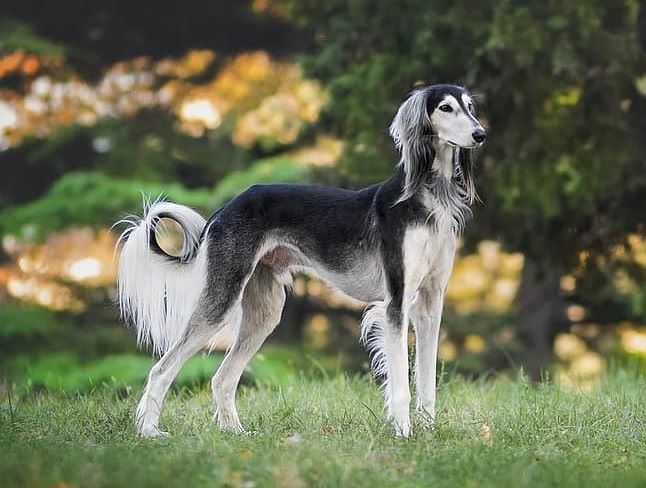While the Saluki is indeed a fast dog breed, it does not pose an outright speed advantage over the Greyhound, eventually making it marginally less adept at outrunning the latter. To understand this in detail, let’s compare the two breeds based on speed, stamina, and historical uses. Furthermore, we’ll explore how their physical and physiological traits come into play in reaching these conclusions.
Speed Comparison
When it comes to sheer speed, the Greyhound has a clear advantage over the Saluki. Averaging over the data available, we can make a table showcasing their top speeds:
| Breed | Top speed (mph) |
|---|---|
| Greyhound | 40-45 |
| Saluki | 35-40 |
As evident from the table, Greyhounds not only reach greater top speeds than the Saluki but also maintain a high average speed.
Stamina and Endurance
In terms of stamina and endurance, the Saluki edges out the Greyhound. Adept at lengthy, strenuous chases, Salukis were historically bred in regions where they had to cover vast expanses for hunting purposes.
- Grayhounds are mainly adapted for sprinting, notable for their ability to excel in short-distance races.
- Salukis, on the other hand, are well-suited for long pursuit and sustained tracking over long distances.
Thus, the Saluki’s inherent stamina results in a higher likelihood of outlasting their prey, whereas the Greyhound’s advantage lies in rapid acceleration and swift capture.
Historical Uses
Both Salukis and Greyhounds have rich histories that showcase their respective strengths in hunting and racing:
Saluki History
- One of the oldest dog breeds, Salukis date back nearly 4,000 years.
- The ancient Egyptians and some Middle Eastern cultures utilized Salukis primarily for hunting mammals such as gazelles, rabbits, and foxes.
- Saluki hunts relied on a combination of speed, endurance, and stealthful tracking abilities.
Greyhound History
- The Greyhound’s history also stretches back several millennia, with roots in ancient Egypt and Greece.
- The breed gained immense popularity in medieval England for its speed, where it was employed in hunting hares.
- As the sport of coursing grew in popularity, so did the Greyhound’s reputation as a supremely fast and agile racer.
Physical and Physiological Characteristics
While both breeds possess an extremely slender and agile build optimized for speed, some differences affect their capacity for outrunning one another:
Greyhound Traits
- Lean, aerodynamic body
- Immense lung capacity and efficient circulatory system for instant acceleration and top sprinting speed
- High fast-twitch muscle fibers that facilitate sprinting
- Less body fat, resulting in minimal padding for extended runs
Saluki Traits
- Slightly lighter, taller, and more flexible than Greyhounds
- Efficient cooling system for sustained energy in longer chases, suitable for the desert climates they’re derived from
- High slow-twitch muscle fibers, allowing for greater endurance
- Longer legs, which facilitate longer strides and adaptability to rough terrains
From this comparison, it is clear that while the Saluki might not outrace the Greyhound in a short sprint, its endurance and stamina give it a competitive edge in sustained pursuits, particularly across harsh terrains.
Factors Affecting Speed and Performance in Racing Dogs
While we’ve established that Greyhounds generally outrun Salukis in terms of raw speed, various factors can influence the running performance of individual dogs:
- Fitness:
- Muscle strength and cardiovascular fitness greatly impact a dog’s running prowess.
- Regular exercise and conditioning are crucial to maintain optimal performance levels.
- Training:
- Speed, agility, and endurance training can enhance a dog’s performance in racing or hunting scenarios.
- Proper training techniques are essential to prevent injuries, promote synergy between handler and dog, and develop the dog’s inherent abilities.
- Nutrition:
- A well-balanced and nutritious diet fuels the energy needed for high-performance feats.
- Different dog breeds have varying dietary requirements that must be taken into account.
- Temperament:
- A dog’s natural temperament and demeanor factor into their racing ability.
- Focus, persistence, and motivation are all desirable qualities in racing dogs.
- Environmental conditions:
- The temperature, terrain, and overall weather conditions can significantly impact a dog’s performance during a race.
- Some breeds perform better in specific climates and environments.
Given these factors, an individual Saluki may outrun a particular Greyhound depending on specific circumstances, or vice versa.
Distinctive Styles of Running
Both Salukis and Greyhounds have their unique ways of covering ground when chasing prey or racing. These methods highlight their respective strengths and adaptations as fast and enduring canines.
Greyhound Running Style
- Double suspension gallop: The Greyhound employs a double suspension gallop, a technique where the dog is airborne twice during each stride, to propel themselves forward at incredible speeds.
- Short bursts: Known for rapid acceleration, Greyhounds utilize their energy in quick, powerful bursts, completing races in a matter of seconds.
Saluki Running Style
- Single suspension gallop: In contrast to the Greyhound, Salukis use the single suspension gallop to cover greater distances steadily, efficiently conserving energy for the long haul.
- Extended chase: Salukis maintain a swift pace over more extended periods, enabling them to keep their quarry within sight and gradually close the distance.
Greyhound and Saluki Racing Events
Racing events for these breeds showcase their respective strengths, with listed examples offering insight into how their speed and endurance are put to the test:
| Racing Event | Breed(s) | Description |
|---|---|---|
| Straight Racing | Greyhound | Participants race over a straight , flat course, typically over distances ranging from 200 to 400 meters, emphasizing the breed’s top speed. |
| Coursing | Greyhound | Dogs compete against each other on a predetermined track in pursuit of an artificial lure, showcasing their speed, agility, and hunting instincts. |
| Oval Track Racing | Greyhound | Similar to coursing, but on an oval-shaped track, further emphasizing agility and cornering ability. |
| Open Field Coursing | Saluki | Salukis are judged based on speed, endurance, and agility as they pursue live game such as hares or lure coursing equipment over rough terrains. |
This exploration into various factors, running styles, and races demonstrates that individual performance cannot be solely attributed to breed characteristics, adding nuance to the question of whether a Saluki can outrun a Greyhound. While breed-specific qualities set a foundation, the influence of external factors and the unique attributes of each dog must be considered.




